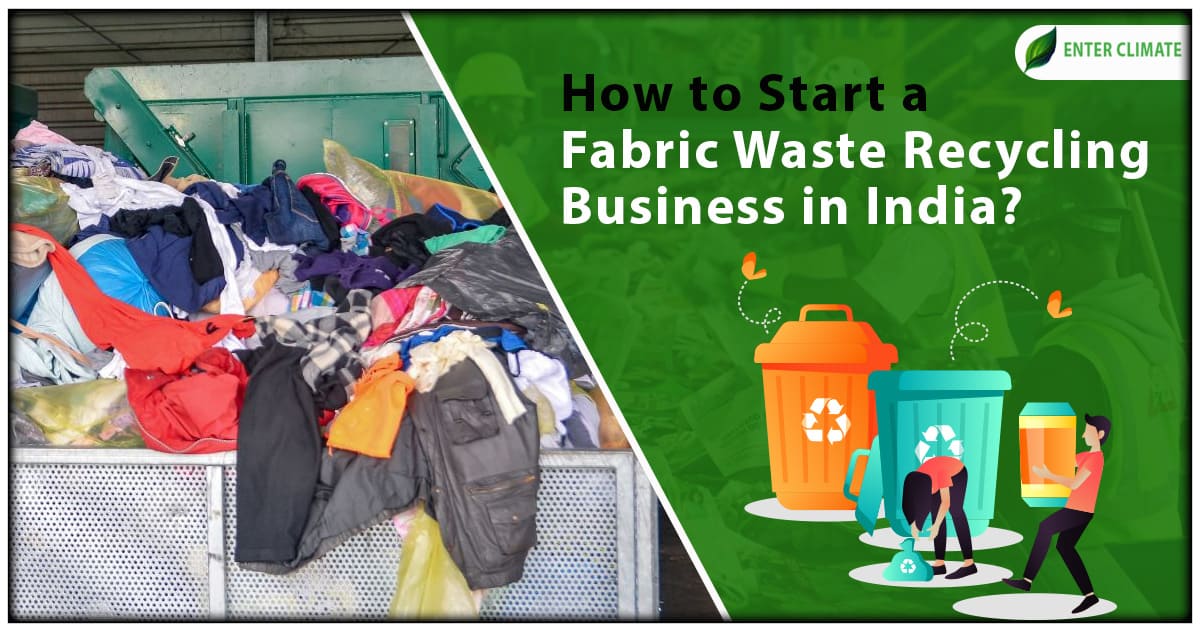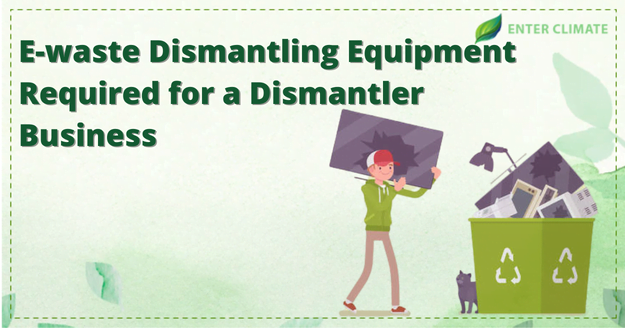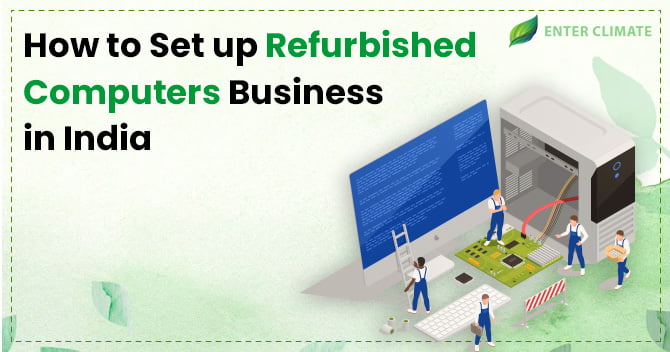How to Start a Fabric Waste Recycling Business in India?
 25 May, 2023
25 May, 2023 
Fast fashion is leading to huge piles of clothing being discarded each year. This has an adverse impact on the environment as the manufacturing of clothes uses raw materials and other valuable resources like water and fuel. The current fashion industry uses high volumes of non-renewable resources, like petroleum, to produce clothes that are used only for a short period, after which the materials are largely lost. So is there a lucrative business opportunity to turn unwanted garments into recycled fabric for reuse? Fabric waste recycling today is one of the best approaches to consider in moving towards a circular economy in the textiles industry in India. The market for cheaper alternatives to new clothes is huge. With a strong population of more than 1.4 billion, we also have one of the most advanced textile industries in the world. Along with the benefits of waste fabric recycling, these fabric recycling businesses will be in huge demand in the near future. From the resource recovery and mitigating the adverse environmental impact of disposal of recyclable cloths, a fabric waste recycling business can have many advantages, which we will discuss in this article, along with the business setup stage and legalities of starting this business.
Fabric recycling on a commercial scale typically involves simple stages in the production process and can generate a decent profit. Clothing that has gone out of fashion, faded and worn-out dresses, or even clothes that have never been worn are frequently discarded nowadays. Fabric waste recycling can convert this opportunity into a highly profitable business with a considerably low initial investment.
Waste/ Old Fabric Recycling Process
The fabrics used today are complex combinations of fibres, fixtures and accessories. They are made from problematic blends of natural yarns, man-made filaments, plastics and metals. Mechanical recycling is the most popular recycling technique in the fabric waste recycling business, followed by chemical and biochemical recycling.
Mechanical recycling: this method can use two approaches- the melt-extrusion process, where shred-ding, crushing, and grinding of waste, followed by melting and re-extruding to obtain fibres for subsequently being re-spun into yarns or production of non-woven panels. Synthetic fabrics such as nylon or polyester can be cut into flakes and converted back to fibres by melt-extrusion either by direct extruding into fibres or by converting flakes into pellets or chips by pelletising, followed by melt-extrusion into fibres.
The second path involves cutting, shredding, and carding of fabrics to open up the fibres that are used to produce various building and industrial applications. Shredded or crushed textile wastes are heat pressed to produce panels or sheets for multiple applications such as thermal and noise insulation, reinforcing materials, and industrial materials
Chemical Recycling: a fabric waste recycling business can also be performed with certain chemicals through depolymerisation and polymerisation techniques. In the former, plastic polymers (e.g. polyester)are depolymerised into monomers or oligomers. In the latter stage, the fibres are repolymerised into new fibres or materials as per the needed characteristics. The dissolution approach can also be used, in which the separation, filtration, and regeneration of fibres take place. The dissolution route is used for cellulose fibres such as cotton or viscose,
Biochemical recycling: this process uses environmentally friendly enzyme treatment on old fabrics to break down their polymers into monomers. Biochemical recycling usually starts with an acid or alkali pre-treatment process to break down the macrostructure of the fibre. These monomers can be reused in polymer production or utilised in various other applications.
How to start a fabric waste recycling business?
Starting a fabric waste recycling business involves several steps. Here’s a general guide to help you get started:
Stage 1: Research and Feasibility Study
Conduct market research in order to understand the demand for fabric waste recycling in your target area. Identify potential customers such as textile manufacturers, fashion brands, or retailers. Assessment of key factors such as the availability of fabric waste, competition in the market and financial viability of the business, including startup costs and potential revenue streams, is essential.
Stage 2: Business Plan Development
A strong business plan that outlines the objectives, target market, pricing strategy, operational processes, marketing plan, and financial projections must be developed prior to making any significant investment. Including details about the type of fabric waste you will recycle (e.g., cotton, polyester, denim) and the recycling techniques must be a part of this planning.
Stage 3: fulfilling Legal and Regulatory Compliance
The entrepreneur must conduct proper research and comply with the legal requirements and regulations related to waste management, recycling, and other trade-related permits. To start a fabric waste recycling business, the necessary licenses and registrations include
- Business Registration
- Factory’s License
- Fire NOC
- GST certificate
- MSME Registration[1]
- Consent NOC from SPCB
- CGWA NOC
Stage 4: Establish Supply Chain
Before Developing connections with waste fabric suppliers, such as textile manufacturers, tailors, or fashion brands, set up collection points or establish partnerships with local businesses to ensure a consistent supply of fabric waste.
Stage 5: Purchasing and Installing Equipment and Infrastructure
Determine the equipment and machinery required for fabric waste recycling, such as shredders, balers, or sorting machines. Set up a processing facility or partner with existing recycling facilities to handle the recycling operations.
Stage 6: Recycling Process
Develop a process for sorting, cleaning, and recycling fabric waste. Explore different recycling techniques, such as mechanical recycling or chemical recycling, depending on the type of fabric waste and its intended reuse.
Stage 7 Marketing and Sales: Create a brand identity and develop a marketing strategy to promote your fabric waste recycling services. Build relationships with potential customers, such as textile manufacturers, fashion brands, or retailers. Highlight the environmental benefits of recycling fabric waste and the value one can provide to their customers.
Key Takeaways for Entrepreneurs
A fabric waste recycling business must also ensure the following for a successful and smooth operation.
- Implement efficient operational processes to manage fabric waste collection, sorting, and recycling.
- Establish quality control measures to ensure the recycled fabric meets the required standards and specifications.
- Prioritise sustainable practices throughout your operations, such as reducing energy consumption, minimising water usage, or exploring renewable energy sources.
- Develop a system for measuring and reporting the environmental impact of your fabric waste recycling activities.
- Always keep looking for improvement and innovation.
Advantages of starting a fabric waste recycling business
The finished fabric is inspected, rolled onto bolts, and packaged for distribution and sale to garment manufacturers, retailers, or other end-users. Fabric waste recycling offers several advantages, both environmental and economic. Here are some key benefits:
Waste Reduction: Fabric waste recycling diverts textile waste from landfills, reducing the amount of waste that ends up in the environment. This helps minimise the environmental impact of textile disposal, conserves landfill space, and reduces the release of pollutants and greenhouse gases associated with landfill decomposition.
Resource Conservation: Recycling fabric waste allows for the recovery and reuse of valuable resources, such as fibres, yarns, and dyes. This helps conserve natural resources like water, energy, and raw materials used in textile production. By recycling fabric waste, the need for virgin materials is reduced, reducing the strain on ecosystems and minimising the extraction of finite resources.
Energy Savings: Fabric waste recycling generally requires less energy compared to producing textiles from virgin materials. Recycling processes, such as sorting, shredding, and reprocessing, typically require fewer energy-intensive steps than the initial production of fibres and yarns. This leads to energy savings and a reduced carbon footprint associated with textile manufacturing.
Emissions Reduction: Recycling fabric waste reduces the carbon footprint and environmental impact of textile production. Recycling avoids the energy-intensive processes involved in fibre production, such as cultivation, harvesting, and chemical treatments. This reduces GHG emissions and air pollution associated with textile manufacturing.
Circular economy: fabric waste recycling business can help promote a circular economy in the textile sector by extending the lifespan of textiles. Recycling fabric waste can reintroduce the materials into the production cycle, reducing the need for new raw materials and promoting a more sustainable and resource-efficient textile industry. It helps create a closed-loop system where waste becomes a valuable resource.
Economic Opportunities: Fabric waste recycling can create economic opportunities and generate revenue. Recycling facilities and businesses focused on fabric waste recycling require skilled labour for sorting, processing, and quality control. This can lead to job creation and contribute to the growth of the recycling industry.
Sustainable Fashion: Fabric waste recycling supports sustainable fashion practices by enabling the reuse and upcycling of textiles. It provides designers and manufacturers with a sustainable source of materials, allowing them to create new products with reduced environmental impact. Fabric waste recycling encourages a circular approach to fashion, promoting more sustainable consumption and production habits.
Innovation and Creativity: Fabric waste recycling stimulates innovation and creativity within the textile industry. Designers, entrepreneurs, and researchers can explore new ways to repurpose and transform fabric waste, leading to the development of unique and eco-friendly products.
Conclusion
Overall, fabric recycling offers a range of benefits to the business, from economic to environmental. These businesses help reduce waste, conserve resources, promote sustainable practices, and reduce imports. Also, one must keep themselves updated on the latest technologies, trends, and innovations in fabric waste recycling. Therefore improving your processes, exploring new recycling techniques, and seeking opportunities to enhance the value you provide to your customers are imperative for the business. Starting a fabric waste recycling business requires careful planning, knowledge of the industry, and a commitment to sustainability. Knowledge of the waste processing business can help you collaborate with local organisations. It can open new avenues for sourcing raw materials, market to finished products and assist in creating awareness about the benefits of adopting recycled fabric. Therefore, seeking guidance from experts in waste management and recycling can help the entrepreneur not only in expediting the licensing needs but also help in networking within the fabric recycling sector.
Read our Article:The Process Of Establishing A Yarn/Textile Processing Unit In India













